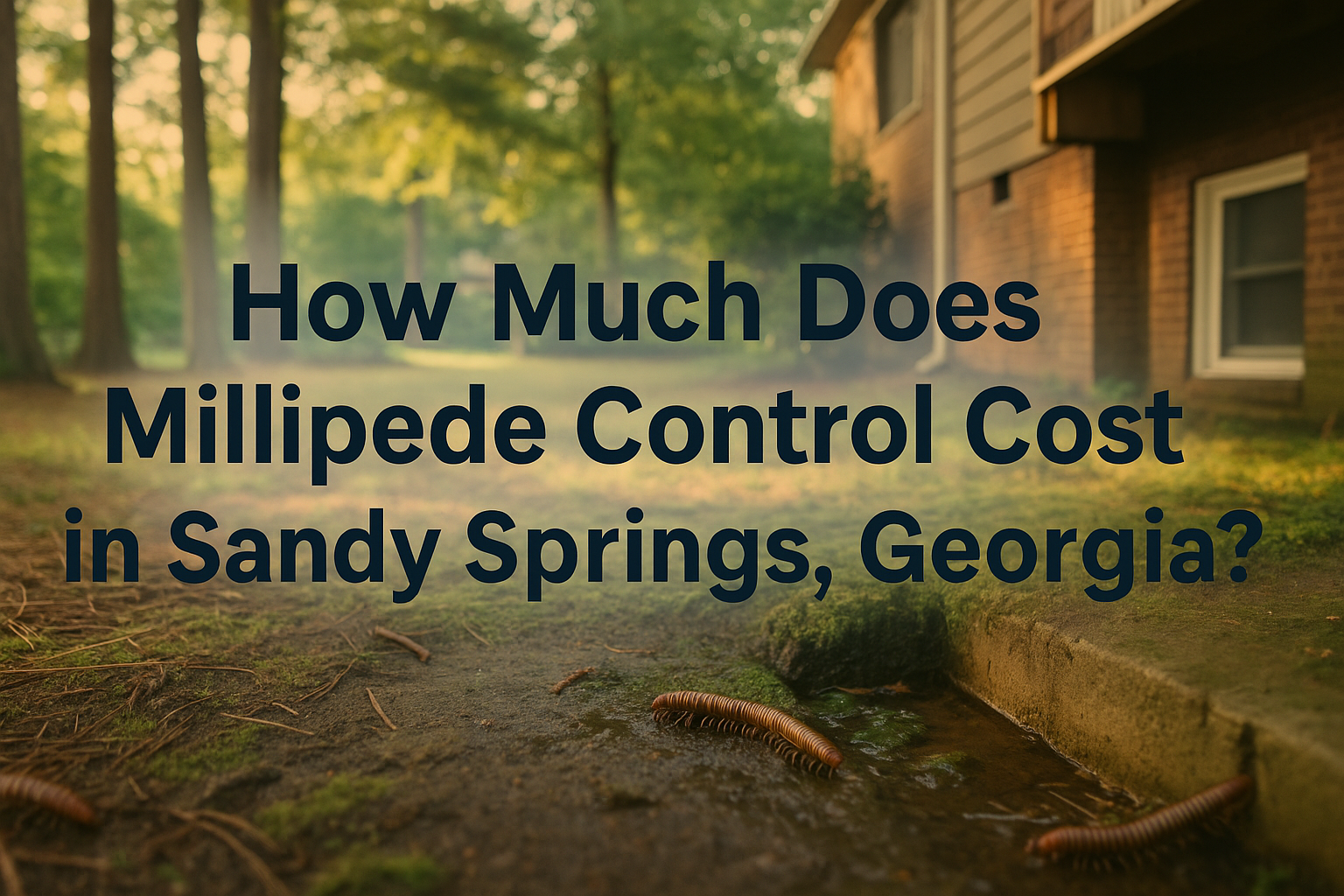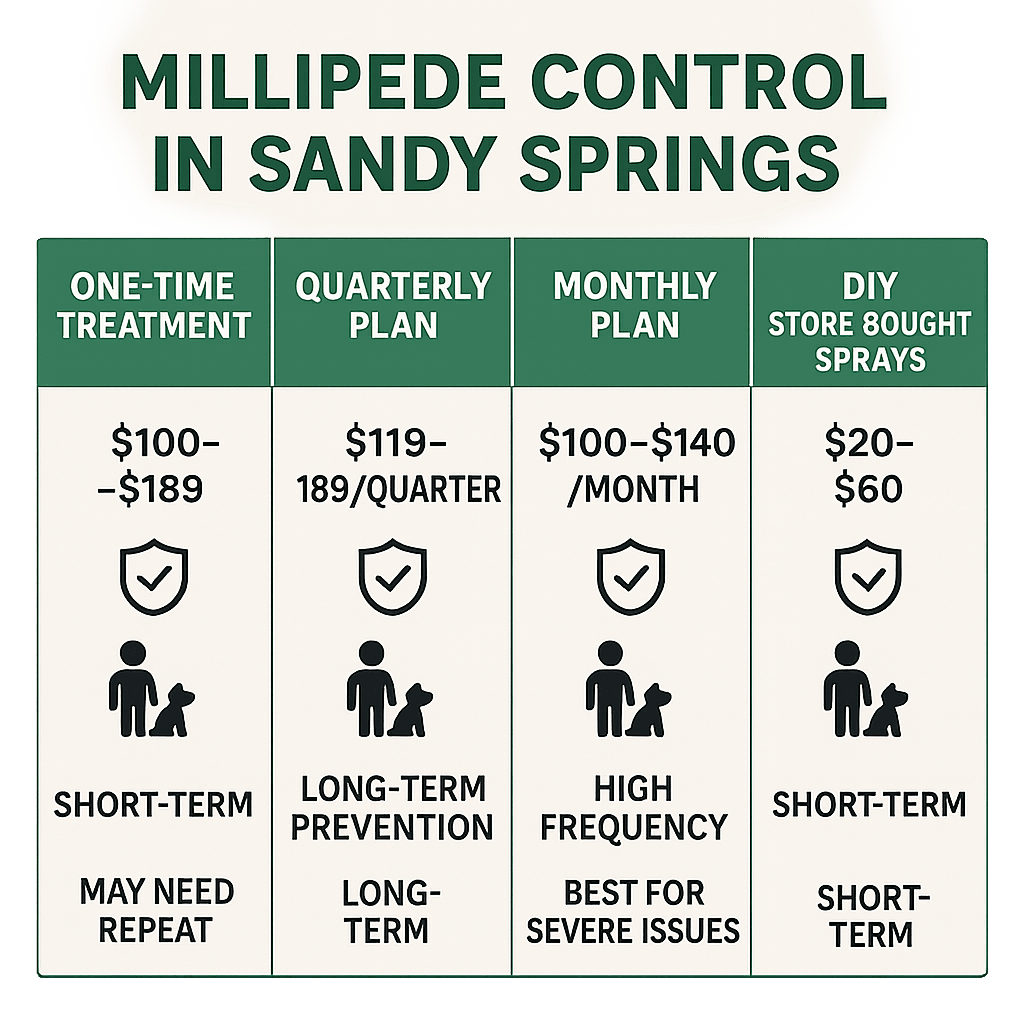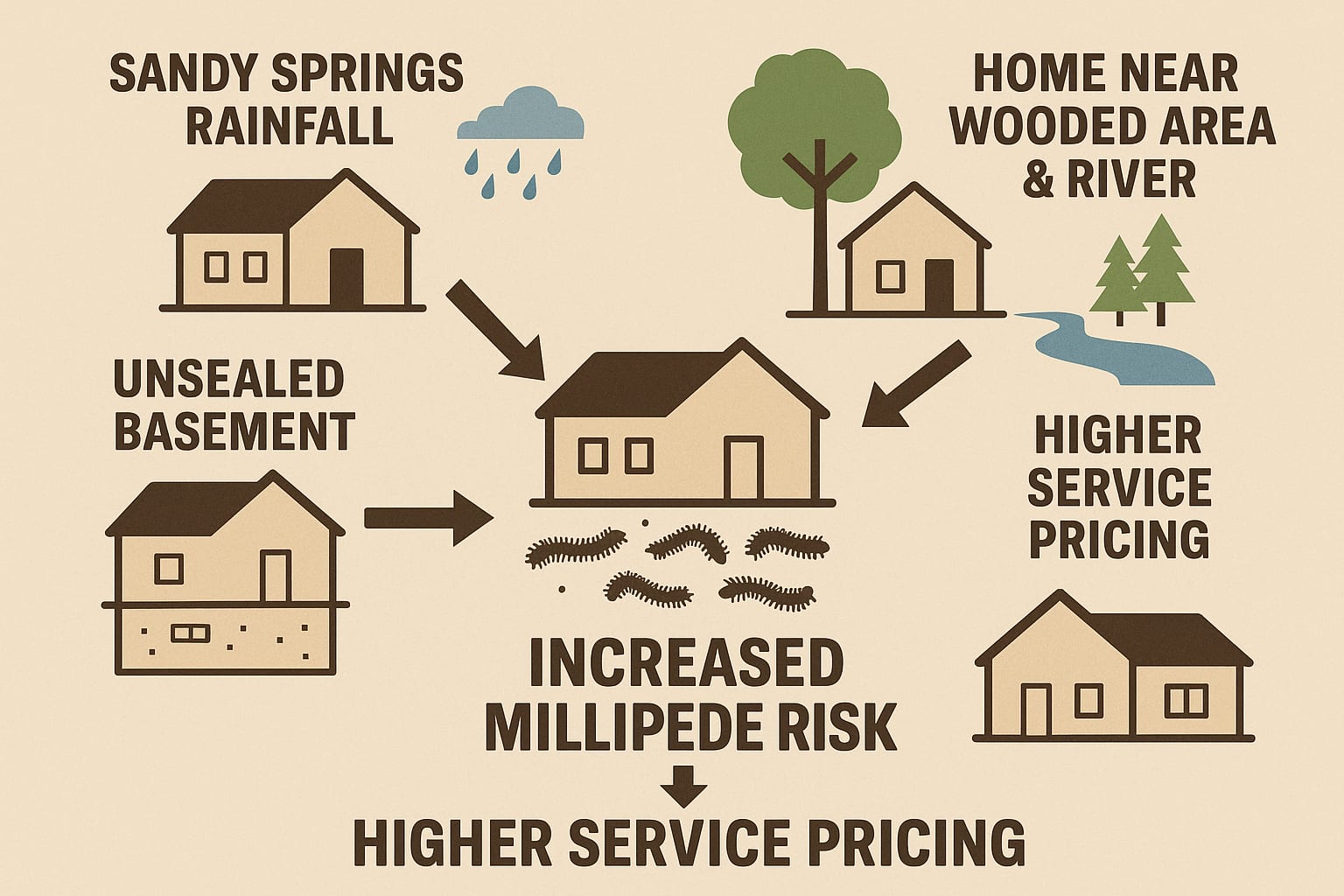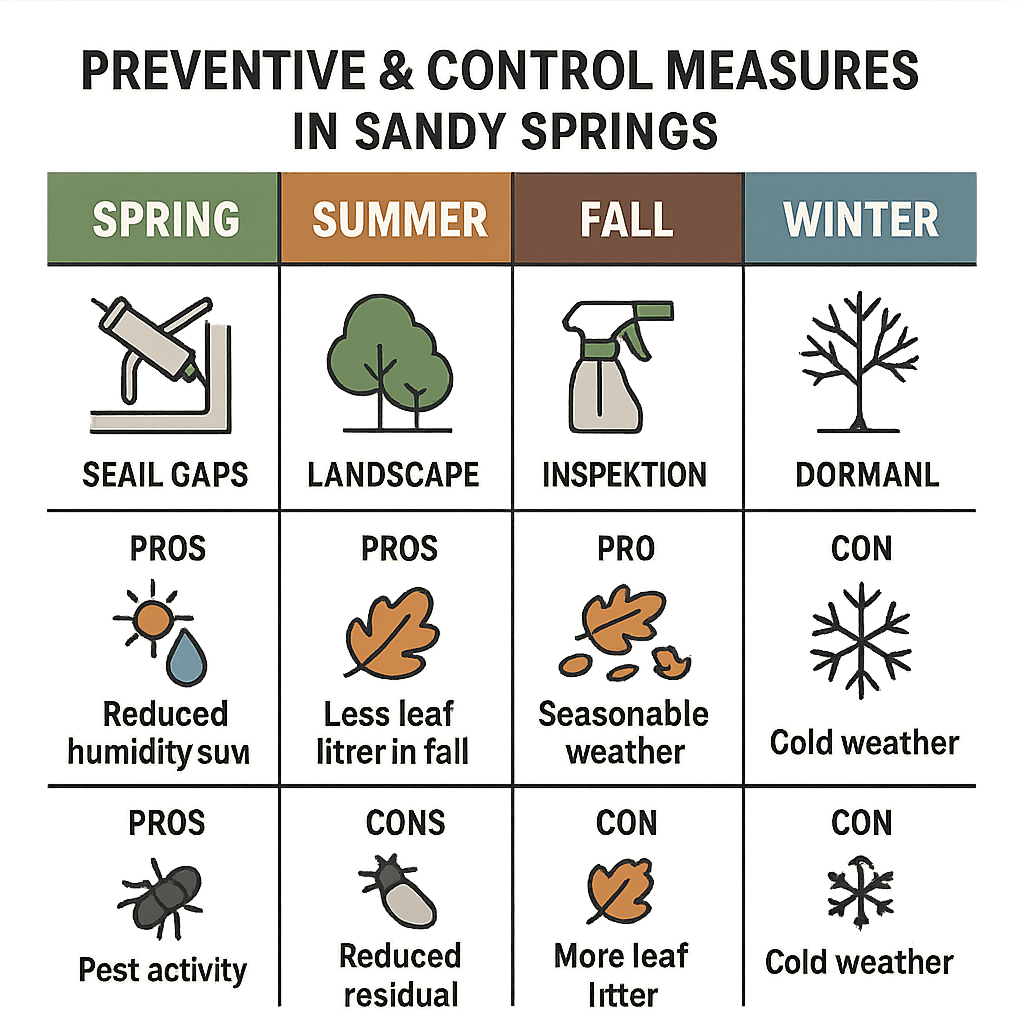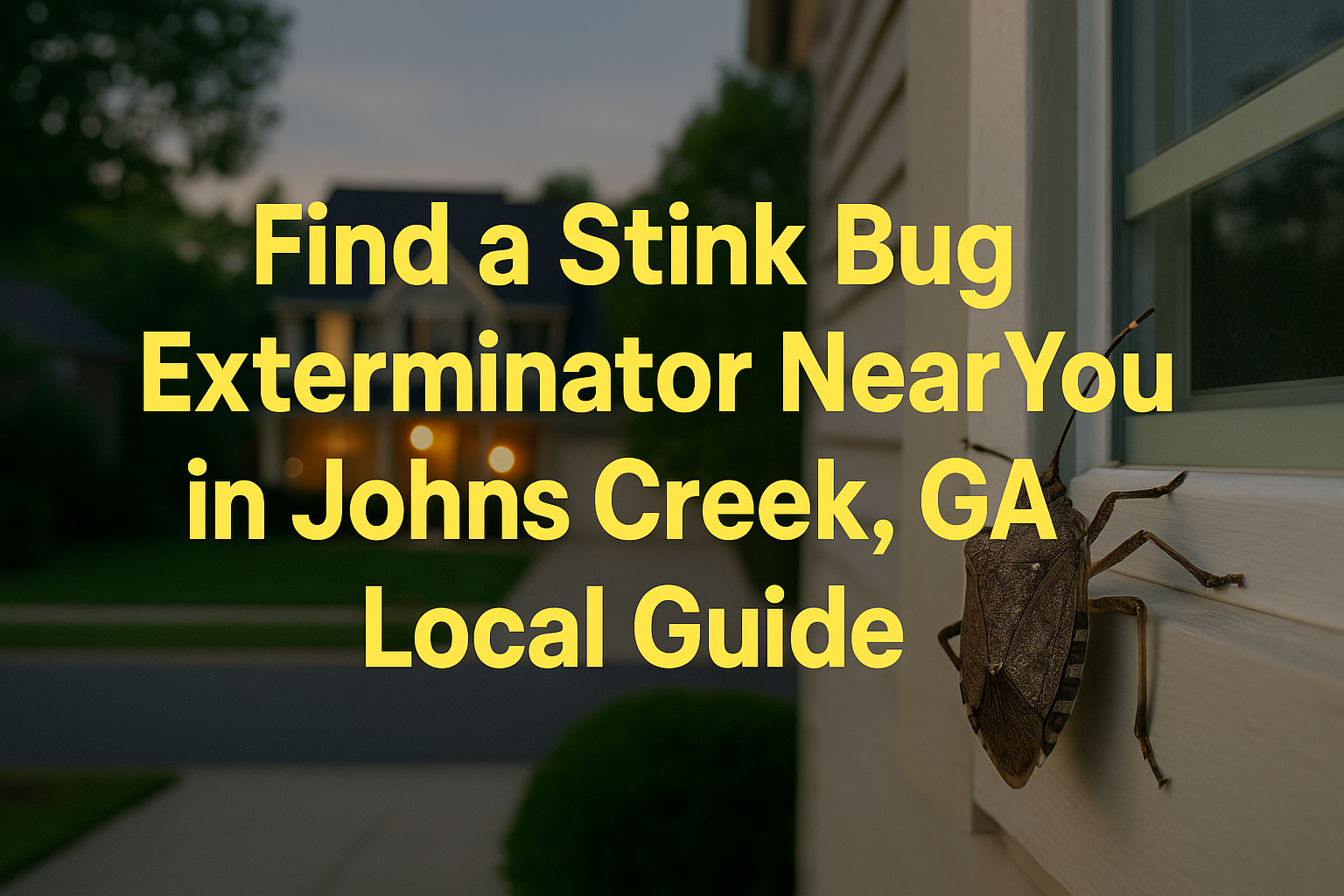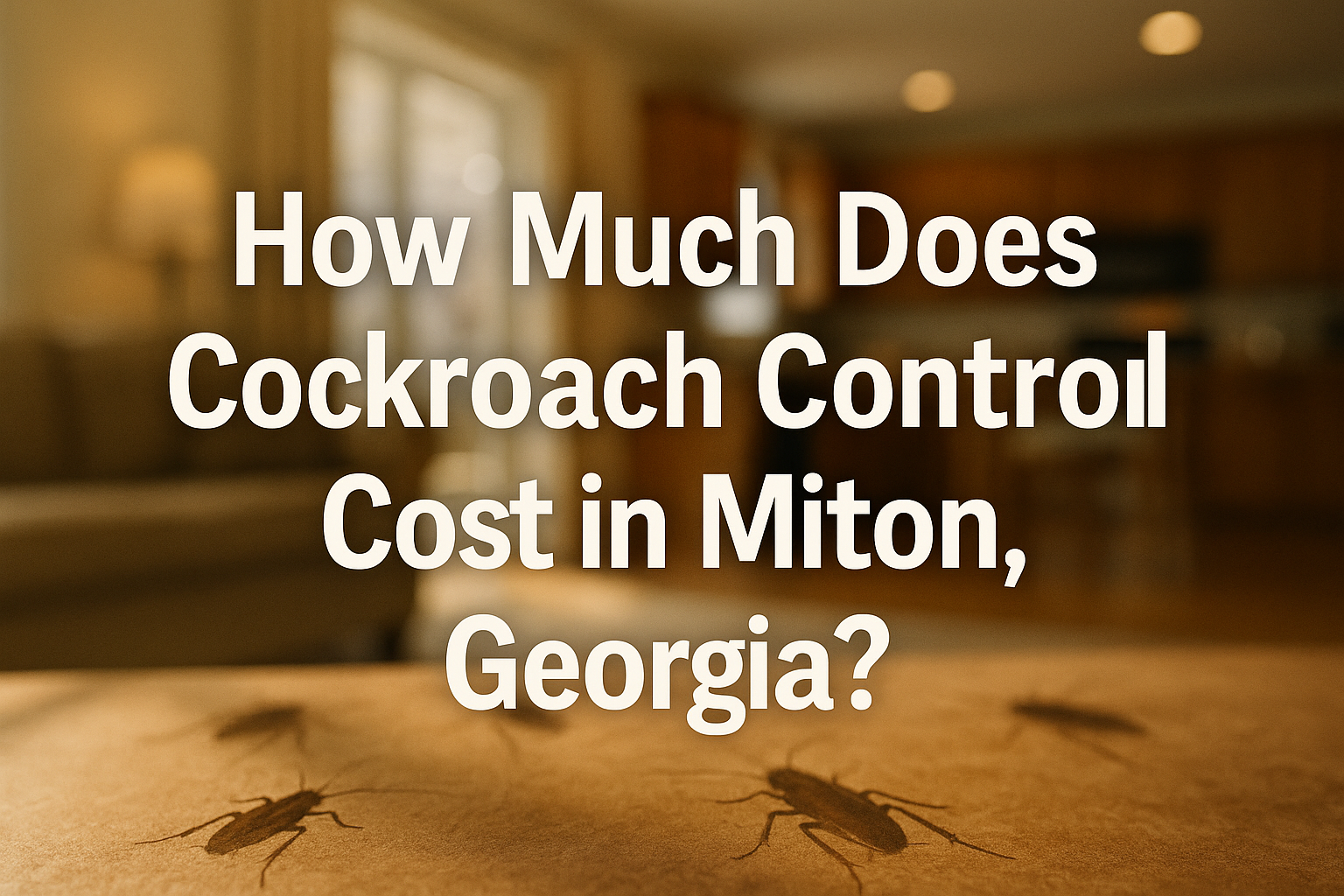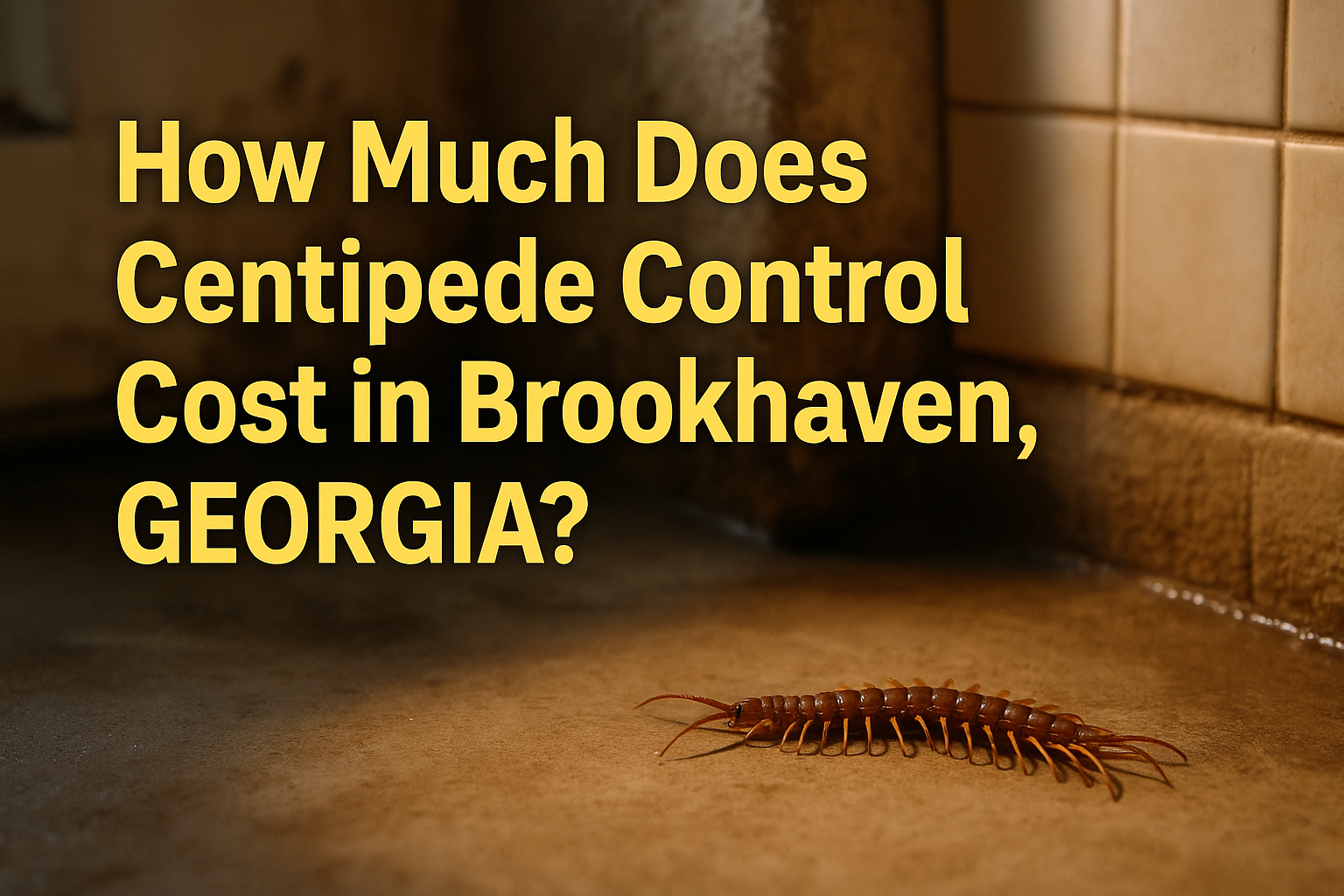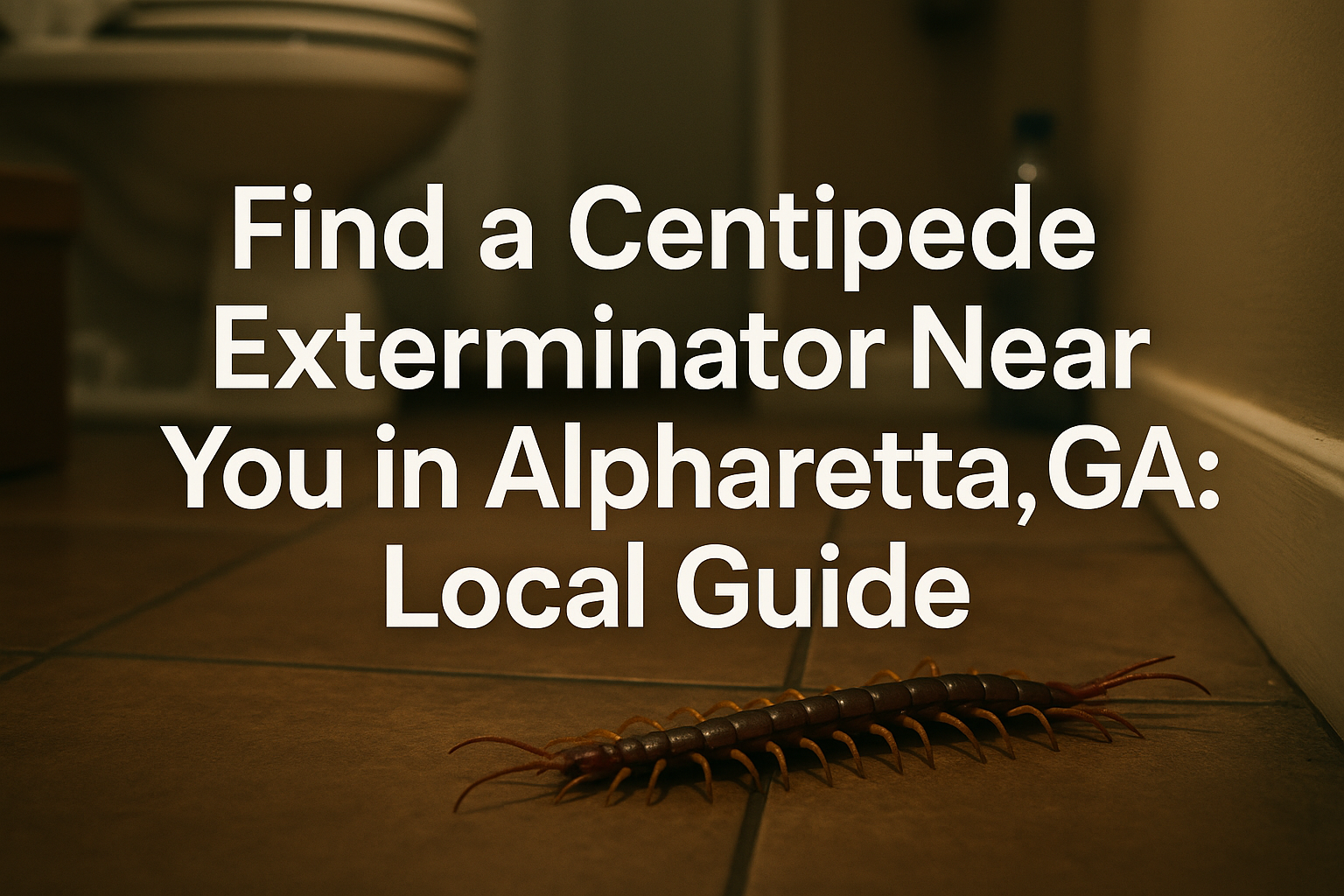Why Millipedes Are a Big Deal for Sandy Springs Homeowners
If you’ve noticed small, black or brown critters curling up on your basement floor or scurrying across your bathroom tiles after a rain, you’re definitely not alone—millipedes are a common problem for homeowners here in Sandy Springs. That’s why millipede control Sandy Springs professionals are seeing more calls during muggy weeks and stormy seasons. Thanks to our humid climate and all the lush, wooded neighborhoods like North Springs, Riverside, and Dunwoody Panhandle, these pests seem to think of our homes as their own personal retreat every time the moisture builds up or storms roll through.
It’s not just the surprise of finding one (or a dozen) camping out in your shower or crawlspace that’s annoying. Millipedes love gathering anywhere there’s moisture, and with so many homes in Sandy Springs surrounded by pine trees and shaded yards, conditions are just right for these guys to sneak inside. Left unchecked, they can become a regular issue—especially in spots that stay damp, like unfinished basements or under the deck.
While millipedes aren’t dangerous or destructive, their numbers add up quickly, and nobody wants guests who roll themselves up the moment you spot them. Plus, the more moisture and organic debris you have around, the happier they’ll be to stick around all season long. That’s why it makes sense to address millipede infestations with a little help from the pros—otherwise, dealing with them becomes part of your routine.
What does it really cost to kick millipedes out and keep them out? In millipede control Sandy Springs services, most professional pest control visits run somewhere between $100 and $189 each, depending on who you call, the size of your property, and how often you need service. A lot of local companies also offer bundled plans covering millipedes and other pests, with monthly rates ranging from $36 up to around $140. Given our humid climate, treating just once a year won’t cut it—instead, quarterly or monthly maintenance tends to be the go-to to stay ahead of future invasions.
Below, you’ll find a breakdown of your main options for millipede control Sandy Springs treatment, a look at what really drives those prices, and the most effective ways to keep millipedes out of your home for good. If you’re tired of sharing your space with these unwelcome visitors, you’re in the right place to get ahead of the problem—once and for all.
What Shapes the Price of Millipede Control Sandy Springs?
If you’re calling around Sandy Springs for millipede control, you’ll notice prices aren’t just plucked out of thin air. There’s actually a whole mix of factors that influence your quote, and understanding the true cost of millipede control Sandy Springs can save you money—and headaches—when those pests show up indoors.
- Your Home’s Size and Layout Matter
If your property is on the larger side, or has a tricky yard full of beds and mulch, it’s going to require more product and more time for the techs to do a thorough job. That’s why single treatments usually run anywhere from $100 up to $189. Small condos with minimal landscaping might be on the lower end, while bigger homes in leafy neighborhoods like Huntcliff or Spalding Lake often sit at the top. - How Bad Is Your Infestation?
If you spot the occasional millipede making a run for it after a rainy night, you might get by with a one-time millipede control Sandy Springs treatment. If they’re popping up in basements and crawl spaces every week, you’re probably looking at a monthly or quarterly plan instead—typically $36 to $140 per month. Tackling a serious, ongoing millipede problem in Sandy Springs will always cost more than nipping it in the bud early.
- Treatment Methods Make a Difference
You get what you pay for. Sure, store-bought sprays are cheap and cheerful, but professional-grade applications last longer and are a lot safer for your pets and kids. That expertise (and peace of mind) factors into the bill, but it also means you’re not having to treat over and over again. - The Level of Protection You Choose
It’s not just about millipedes. Many Sandy Springs homeowners pick multi-pest plans that cover various creepy-crawlies for just a bit more, and opt for premium service if they want pest-free peace of mind year-round. Your specific service plan, basic or premium, will nudge the price up or down. - Location, Location, Location
Got a home tucked up near a creek, greenbelt, or heavy woods? Properties in spots like Glenridge or along Spalding Lake often need extra attention because they’re prime hangouts for millipedes. Expect slightly higher prices in those areas.
No two homes—and no two infestations—are the same. That’s why reputable companies like Anthem Pest Control always start with an inspection before giving you a quote for millipede control in Sandy Springs. The goal is to match the right solution to your actual needs, so you’re not overpaying or under-protected. With the right millipede control Sandy Springs service, you’ll get a price that fits your situation and enjoy your home without the unwanted guests.
What Shapes the Price of Millipede Control Sandy Springs?
If you’re calling around Sandy Springs for millipede control, you’ll notice prices aren’t just plucked out of thin air. There’s actually a whole mix of factors that shape your quote for millipede control Sandy Springs services, and being in-the-know can save you money—and headaches—when those millipedes show up indoors.
- Your Home’s Size and Layout Matter
If your property is on the larger side, or has a tricky yard full of beds and mulch, it’s going to require more product and more time for the techs to do a thorough job. That’s why single treatments usually run anywhere from $100 up to $189. Small condos with minimal landscaping might be on the lower end, while bigger homes in leafy neighborhoods like Huntcliff or Spalding Lake often sit at the top. - How Bad Is Your Infestation?
If you spot the occasional millipede making a run for it after a rainy night, a one-time treatment for millipede control in Sandy Springs might be enough. But if they’re consistently showing up in basements and crawl spaces every week, you’re probably looking at a monthly or quarterly millipede control Sandy Springs plan—typically ranging from $36 to $140 per month. Tackling a serious, ongoing problem will always cost more than nipping it in the bud early.
- Treatment Methods Make a Difference
You get what you pay for. Sure, store-bought sprays are cheap and cheerful, but professional-grade applications last longer and are a lot safer for your pets and kids. That expertise (and peace of mind) factors into the bill, but it also means you’re not having to treat over and over again. - The Level of Protection You Choose
It’s not just about millipedes. Many Sandy Springs homeowners pick multi-pest plans that cover various creepy-crawlies for just a bit more, and opt for premium service if they want pest-free peace of mind year-round. Your specific service plan, basic or premium, will nudge the price up or down. - Location, Location, Location
Got a home tucked up near a creek, greenbelt, or heavy woods? Properties in spots like Glenridge or along Spalding Lake often need extra attention because they’re prime hangouts for millipedes. Expect slightly higher prices in those areas.
No two homes—and no two infestations—are the same. That’s why reputable companies like Anthem Pest Control always begin with a detailed inspection before recommending a solution for millipede control in Sandy Springs. The goal is to match the right treatment to your specific needs, so you’re not overpaying or under-protected. Get a quote that fits your situation and enjoy peace of mind knowing your home is protected with professional millipede control Sandy Springs residents trust.
Why Millipedes Love Sandy Springs Homes (And What That Costs You)
If you’re in Sandy Springs, especially around neighborhoods like Woodland Forest or Riverside, you know how relentless millipedes can be each spring and fall. It’s not just bad luck—our climate here is humid and warm, and all that rain just draws millipedes up from the soil in droves. If your basement is older, your crawlspace isn’t sealed, or your property stays shaded and damp, you’ve basically set out the welcome mat for these pests.
Let’s talk about the details most folks don’t think about. Brick homes hold up better than wood when it comes to keeping millipedes out, and even the tiniest foundation crack is an open invitation. We see this all the time: homes close to the Chattahoochee River, or those sitting on low ground where water likes to hang around, end up battling millipedes year after year. Throw in thick landscaping or mulch beds hugging the house and you’re giving them a secret highway straight inside.
Every one of these factors makes treatment more involved. If you’re dealing with regular invasions because your lot is wet or shady, you’ll probably need more frequent moisture control and barrier applications. Homes with multiple access points—think old vent covers, loose window wells, or busted weatherstripping—may need ongoing service visits to really keep the millipedes out. All these variables can add up in your pest control costs over time.
- Shady lots and damp foundations = more millipedes and higher service frequency
- Unsealed crawlspaces and cracks in older homes = more complex (and expensive) to treat
- Proximity to creeks or the river amplifies moisture issues and recurring invasions
- Brick and sealed cement hold up better than wood or siding
Understanding these site-specific factors upfront will help you make smart decisions about how often you’ll need pest control and what you might budget for the season. Give your home a good look inside and out so you can get ahead of the problem—and avoid any surprise expenses down the road.
Smart Moves to Prevent Millipedes Around Your Sandy Springs Home
No one wants to deal with a wave of millipedes skittering through their basement after a rainy weekend. If you’re hoping to make those little guys a non-issue—and avoid surprise costs later—show your place a little TLC, inside and out. Here are some straight-shooting tips that work great for homes in Sandy Springs, especially in spots like Windsor Heights or North Springs where older houses might have a few more gaps and cracks than the newer builds.
- Seal Up Entry Points: Check along your foundation, windows, and doors for any cracks or gaps. Grab a tube of caulk or some weatherstripping, and close up those easy millipede highways. It’s a quick fix, but it makes a real difference.
- Keep Things Dry: Millipedes love damp, humid places. If you have a basement, crawlspace, or tend to get steamy laundry rooms, consider a dehumidifier. And if you spot any leaks – under sinks, around your water heater, or in the basement – get on it fast! Even a slow drip is an open invitation to pests looking for a moisture fix.
- Handle Your Yard: Good drainage goes a long way. Keep gutters clear and running, and make sure downspouts push water away from your foundation. Try not to layer mulch too thickly against your house—millipedes love hiding under wet, decaying stuff close to your walls.
- Stay on Top of Lawn Cleanup: Fallen leaves and deadwood collect moisture and give millipedes the perfect breeding ground. Make seasonal cleanups a habit—before they pile up around walkways, patios, and behind shrubs.
- Call in the Pros: Even if everything looks fine, scheduling an annual (or quarterly) inspection can catch trouble while it’s still small. Local pest experts often bundle millipede treatments with wider pest control services so you aren’t paying for separate visits every time. Early action here saves you the cost and headache of a full-blown infestation.
These steps aren’t just about today—they’ll help keep your property value intact, your maintenance budget in check, and your home comfortable year-round. Coming up, we’ll lay out a handy seasonal checklist you can follow to make millipede prevention second nature.
When to Bring in the Pros for Millipede Control Sandy Springs
If you’re living in Sandy Springs, you already know our weather is anything but predictable—and so are the bugs. Millipedes seem to love showing up just when spring is at its soggiest or when fall rains soak the yard—usually right around early spring and late autumn. The reason’s simple: damp soil lures them out, and before you know it, they’re trying to sneak indoors for shelter. That’s why these months see a major spike in calls for millipede control Sandy Springs homeowners trust, especially in neighborhoods like Spalding Lake and Glenridge.
So when’s the smartest time to act? Honestly, it’s before you see a single millipede in your hall! Booking your pest service right before those rainy seasons hit doesn’t just prevent unwanted guests—it often snags you a better deal, too. Plenty of providers around Sandy Springs (think Anthem Pest Control and others) run early-bird or routine maintenance specials. That way, you’re protected when the big population booms happen and you’re not dealing with a pricey emergency visit later.
Summer’s a different story. The dry spells aren’t as friendly to millipedes, so if you’re thinking about checking and sealing your foundation or adjusting the landscaping, now’s the ideal window. Get those cracks sealed, trim back mulch and leaves a little more than usual, and you’ll make your home a fortress for the rest of the year.
Of course, every yard in Sandy Springs is a bit different. After heavy leaf falls and autumn rainstorms, it’s smart to look for new entry points around doors, garages, and basements. That’s typically when a lot of homeowners make their preventive service appointments for millipede control Sandy Springs experts recommend. And if you’re someone who wants to keep costs steady, a regular contract with a local pest control company can keep your expenses low—not to mention your home millipede-free, season after season.
Get Your Free Millipede Control Quote Today
Don’t let millipedes take over your Sandy Springs home. Anthem Pest Control makes it easy to find out just how affordable it is to send those pests packing. Call us at 877-3718-5196 or visit our website for a free, no-pressure quote and expert advice from locals who know the job. Want to compare prices in nearby areas? Check out Millipede Control Costs in Milton, GA. We’re here to help you enjoy a worry-free, millipede-free space!
Millipede Control FAQs for Sandy Springs Homeowners
- Are millipedes dangerous to my family or pets?
You don’t have to worry—millipedes around Sandy Springs aren’t a threat to your loved ones or pets. They’re just a bit of a pain if they wander inside, and can leave behind a stinky smell if accidentally squished. - How often should I schedule pest services?
If you want to keep millipedes (and other pests) out for good, quarterly or monthly visits are usually the way to go. Homes near wooded areas or creeks especially benefit from staying on a regular plan. - Will one treatment get rid of millipedes for good?
A single visit helps, but millipedes are stubborn. Ongoing prevention—plus fixing moisture problems—makes a big difference. Consistency keeps them from making a comeback. - Is professional treatment safe for pets?
Absolutely. Trusted companies like Anthem Pest Control only use products that are safe for both pets and kids. You get peace of mind along with a pest-free home. - What areas of my home are most at risk?
Millipedes love damp and dark spots—think basements, crawlspaces, or bathrooms on the ground floor. Homes close to woods or water are especially likely to see activity. - Can I combine millipede control with other pest services?
Definitely. Most Sandy Springs pest control plans cover a variety of critters—so you can tackle ants, spiders, roaches, and millipedes all for one price. - What happens during an inspection?
Your pest pro will hunt down where millipedes get in, check out moisture issues, and put together a set of recommendations just for your house. - Where can I learn more?
For more insights and helpful tips, visit Anthem Pest Control’s Blog.
If you’ve got more questions or need personalized advice, get in touch with a local pest control expert. They’ll help you protect your home and keep those millipedes where they belong—outside!

